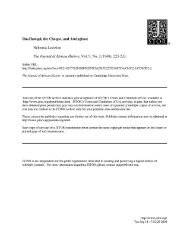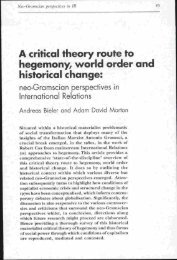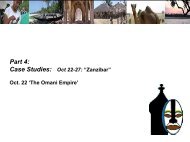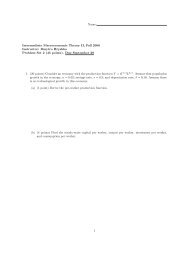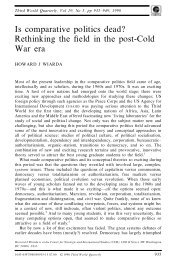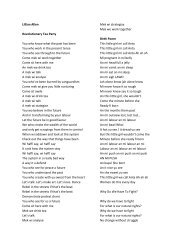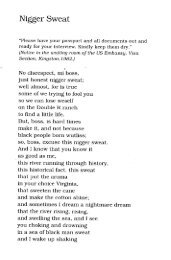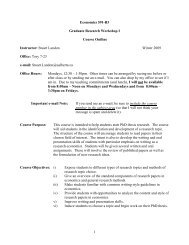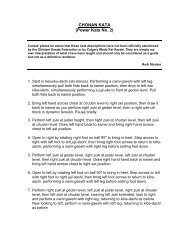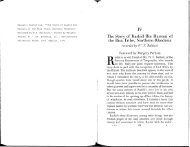personal memories revolutionary states and indian ocean migrations
personal memories revolutionary states and indian ocean migrations
personal memories revolutionary states and indian ocean migrations
You also want an ePaper? Increase the reach of your titles
YUMPU automatically turns print PDFs into web optimized ePapers that Google loves.
movable type was going on in some<br />
languages in the Middle East, it is clear<br />
that the use of movable type for printing<br />
the Arabic language was being avoided<br />
by deliberate choice. Middle Eastern<br />
Languages <strong>and</strong> the Print Revolution deepens<br />
our underst<strong>and</strong>ing of that choice. The<br />
Quranic verses on the medieval block<br />
prints were allowed to circulate so long<br />
as they were simply popular amulets<br />
carried on the person; when printing<br />
with movable type threatened the<br />
accuracy, sanctity, <strong>and</strong> beauty of Qurans<br />
used for study <strong>and</strong> recitation, it was<br />
rejected <strong>and</strong> the block prints<br />
disappeared as well. So long as the<br />
widespread network of scribes was able<br />
to produce manuscripts in sufficient<br />
quantity to fulfill dem<strong>and</strong>, their vigorous<br />
defense of their craft was accepted;<br />
when manuscripts were in short supply<br />
–as was the case in the Ottoman empire<br />
in the 18 th century, when the export of<br />
manuscripts was prohibited – then<br />
Müteferriqa’s argument for the use of<br />
typography won some assent.<br />
But especially this book fills out<br />
the challenges faced over the centuries<br />
in creating fonts for the cursive Arabic<br />
script, with its ligatures between<br />
characters <strong>and</strong> its letters existing in four<br />
forms, <strong>and</strong> in setting Arabic type.<br />
Dem<strong>and</strong> is important as well, Geoffrey<br />
Roper stresses, but other authors stress<br />
the success of lithography because,<br />
reproducing a manuscript, it<br />
simultaneously eased certain technical<br />
problems <strong>and</strong> satisfied aesthetic<br />
preference. Hrant Gabeyan, creator of a<br />
computerized system for setting Arabic<br />
type with all its ligatures <strong>and</strong> letter forms<br />
with great efficiency, concludes on a<br />
hopeful note that "in moving from lead<br />
font to binary coding, <strong>and</strong> from qalam to<br />
laser, Arabic script should not lose its<br />
exquisite <strong>and</strong> multi-faceted qualities."<br />
Middle Eastern Languages <strong>and</strong> the<br />
Print Revolution furthers the history of the<br />
book in many l<strong>and</strong>s, but, as its authors<br />
would agree, much remains to be done.<br />
As the essay on medieval block prints<br />
was being completed, its author learned<br />
http://web.mit.edu/cis/www/mitejmes/<br />
87<br />
that several more had been discovered<br />
in Istanbul; a book lithographed in<br />
Meknès in 1865 is given as the first<br />
printed book in Arabic in Morocco, but<br />
Moroccan scholars have recently found<br />
earlier editions. Book runs are given for<br />
many presses, but the actual readership,<br />
libraries, <strong>and</strong> impact on authors <strong>and</strong><br />
readers are beyond the scope of this<br />
collection, as is a full treatment of the<br />
dialectic between oral, written, <strong>and</strong><br />
printed forms. Still, in underst<strong>and</strong>ing<br />
these other topics, future scholars will<br />
find this beautiful <strong>and</strong> informative book<br />
an essential step.<br />
_______________________________<br />
Fruma Zachs<br />
The Making of a Syrian Identity:<br />
Intellectuals <strong>and</strong> Merchants in<br />
Nineteenth-Century Beirut<br />
Leiden: Brill, 2005<br />
Reviewed by Leila Hudson ∗<br />
Fruma Zachs’s The Making of a<br />
Syrian Identity: is a valuable <strong>and</strong> solidly<br />
researched contribution to the cultural<br />
history of Bilad al-Sham. Zachs’s<br />
attempt to locate indigenous roots of<br />
the twentieth century culture of<br />
nationalism in the milieu of the “middle<br />
stratum” Christians of Mount Lebanon<br />
<strong>and</strong> Beirut fleshes out the long accepted<br />
notion that these bourgeois intellectuals<br />
formed the vanguard of proto-national<br />
Syrian identity. To her credit, she<br />
acknowledges that this is one Syrian<br />
identity in a complex social, historical,<br />
regional cauldron with the inclusion of<br />
the particle “a” in the title. Noting that<br />
Lebanese Catholics <strong>and</strong> Muslims also<br />
had parallel processes of identity<br />
development, she convincingly posits<br />
the development of a Syrian, as opposed<br />
to a Shami or Phoenicianist, identity as<br />
the oldest <strong>and</strong> most influential <strong>and</strong><br />
arguably the most complex. The<br />
∗ Leila Hudson is Assistant Professor in Middle<br />
East history at the University of Arizona.



